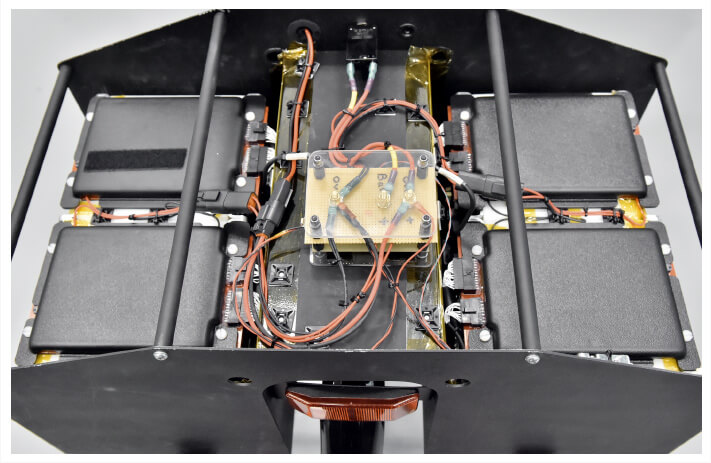40% Cheaper, Fast Charging: Can Sodium-Ion Replace Li-Ion Batteries in EVs?
Experts argue that transitioning from lithium-ion batteries to sodium-ion batteries would make electric vehicles “cheaper than IC-engine vehicles even without subsidies”. But how feasible is this?

Can sodium-ion batteries replace their lithium-ion counterparts in India’s quest for greater adoption of electric mobility?
Latest developments in the electric vehicle (EV) sector seem to suggest that this is possible. Conglomerates like Reliance Industries and startups like the Pune-based Sentient Labs, Roorkee-based Indi Energy and Sodion Energy in Coimbatore are making real strides in this direction, given that sodium-ion technology is less expensive than the current lithium-ion EV battery technology. (Representational image above courtesy Shutterstock/KAIN KAUSHIK)
Some manufacturers have spoken of how Li-ion batteries make up for the most expensive component of an EV, accounting for 40-50% of its cost. If sodium-ion cells are manufactured on a mass scale, many in the sector believe it will make EVs more affordable.
Bala Pachayappa, former chief technology officer of Ampere Electric, who is now the CEO of Sodion Energy, a battery startup, argues that this transition would make EVs “cheaper than IC-engine vehicles even without subsidies”.
“In terms of cost, sodium-ion cells will be slightly more expensive than lead-acid, but cheaper than lithium-ion cells by about 30-40% as per our estimation,” he tells The Better India.
Besides costs, however, sodium-ion technology has a series of other advantages over their lithium-ion counterparts, from availability and battery capacity to impact on the environment.
Making That Transition
It was sometime in 2018 when Bala Pachayappa began looking at alternate battery chemistries to lithium-ion. “We knew that it would take another decade for solid-state batteries to become affordable. Hydrogen is something we looked at as well, but it had some way to go before commercialisation. It was after stumbling into some research work in Singapore that we witnessed how unbelievably well it performed in the laboratory,” he recalls.
He saw that one could discharge the entire sodium-ion battery up to zero volts without affecting the life of the cells. “That is one of the best parts of sodium-ion cells. It also gives 80-90% benefits of lithium titanate oxide (LTO), one of the best lithium cell chemistries that is safe, has a long life and possesses the quality of fast charging. In the laboratory, sodium-ion batteries were getting fully charged in 10 minutes. However, this is all under laboratory conditions. When you commercialise lab technology, you may lose 40-45% of the results or performance seen in the lab. Even then, a sodium ion is better than the LFP (Lithium ferro phosphate) battery in terms of performance. LFP is like second best to Lithium Titanate Oxide in terms of cell chemistry in the Lithium family of cells,” adds Bala.
Seeing the performance of sodium-ion batteries in the laboratory inspired Bala and his partners to establish Sodion Energy the following year in November 2019. The organisation’s mandate is to discover cheaper, safer and reasonably better density alternatives to their lithium counterparts.
“Sodium is a better choice, given that we are developing safer, cheaper and higher-density batteries without mining rare earth materials like cobalt and nickel, an environmentally-toxic commercial activity, and emitting other dangerous chemicals. In terms of density of sodium, irrespective of cell chemistry, you’re looking at somewhere between 95 Watt-hour per kilogram (Wh/kg) to 130 Wh/kg, which is close to batteries currently on the market, ranging from approximately 140 Wh/kg to 180. Even though sodium-ion batteries currently have a lower energy density, they run better at cooler temperatures and possess a greater life span. We have working cells, producing one or two batches of a few lakh cells during our testing period. In terms of cell chemistry, sodium-ion is a proven entity. This sodium-ion cell chemistry allows the battery to charge faster to almost 100% in 20 minutes and is non-flammable. We are on the cusp of commercial production,” explains Bala.
Global Game Changers
The decision of China’s Contemporary Amperex Technology Co., or CATL, the world’s largest lithium cell battery manufacturer, to unveil its latest sodium-ion battery in July 2021 gave immense credibility to sodium ion cells. Reports indicate that the battery is expected to have an energy density of 160 Wh/kg and will take 15 minutes to reach 80% of its charge.
Another interesting development has been Reliance’s decision to buy UK-based sodium-ion battery startup Faradion earlier this month for USD 135 million. Reports indicate that Reliance will invest a further USD 35 million in Faradion to speed up the commercialisation of the latter’s technological products, including batteries meant for electric mobility.
“The cost of battery-grade lithium carbonate has more than tripled in the past 12 months, to above $30 per kg, according to the tracking firm S&P Global Platts. Meanwhile, the International Energy Agency forecasts that demand for lithium will increase by a factor of 43 between 2020 and 2040. Sodium’s abundance means its price is unlikely to rise dramatically in the foreseeable future,” notes this recent article published on Chemical and Engineering News.

Self-Sufficient
Sodium also allows every country to manufacture battery cells on their own without waiting for raw materials from countries like China.
Of course, for this to happen, you need investment in developing an ecosystem and cluster creation. Also, the abundance of sodium is much higher than lithium or potassium. That makes sodium a very important and viable technology for the future.
“The content of sodium in earth reserves is around 2.5% to 3%, or 300 times more than lithium, and is more evenly distributed, according to Jefferies Group LLC analysts. That means it has a major cost advantage. These power packs could cost almost 30% to 50% less than the cheapest electric car battery options currently available. In addition, the price of sodium is less sensitive to market gyrations compared with lithium,” argues Anjani Trivedi, a Bloomsberg columnist.
“Of course, we also have to consider an investor’s perspective. They will wait before investing in something like sodium-ion cells because they’re already invested in Li-ion. This transition is bound to take some time because of the earlier investments in lithium and lack of research, investment and development of sodium solutions. Moreover, sodium-ion batteries will also need a new supply chain since they can’t depend on the one dedicated to their lithium-ion counterparts. However, lower raw material costs will result in a drop in manufacturing expenses. CATL claims that it will have a supply chain running by 2023. Once the supply of sodium ion cells increases and becomes organised in India, all the OEMs will follow suit in shifting away from lithium-ion,” informs Bala.
Given that sodium-ion battery technology is cheaper, non-flammable, and is as efficient if not more than their lithium-ion counterparts, besides the fact the raw materials needed are more locally found, the scope for greater adoption of EVs increases significantly.
“Ultimately, the ability to put cheaper and safer options on the market also means widespread accessibility for price-conscious consumers or resource-constrained nations. Countries like India and South Africa are vying to get on the electric car bandwagon with big, ambitious plans to hit global green targets. However, they just don’t have the resources or access to them — neither financial nor raw materials. Options like the sodium-ion battery offer a clear path to go electric and make headway with their climate change goals,” adds the Bloomberg column.
But even if you go beyond electric mobility, looking at electrification and the requirement for greater storage capacity in the next decade, sodium ion offers a genuine alternative to lithium solutions and will replace lead-acid batteries. Even today, lead acid stationary battery applications are huge and substantial. For example, a stationary lead-acid (SLA) battery continues to be the battery chemistry of choice for backup power, emergency lighting, utilities, security systems, oil and gas explorations, renewable energy systems and other applications.
“Sodium-ion batteries will replace lead-acid,” Bala asserts, adding, “Sodium-ion will not immediately replace lithium-ion, but will definitely replace lead-acid batteries and given how 90% of stationary applications are still powered by lead-acid batteries, the difference sodium ion is going to make for humanity here is potentially huge.”
(Edited by Yoshita Rao)
Like this story? Or have something to share? Write to us: [email protected], or connect with us on Facebook and Twitter.
If you found our stories insightful, informative, or even just enjoyable, we invite you to consider making a voluntary payment to support the work we do at The Better India. Your contribution helps us continue producing quality content that educates, inspires, and drives positive change.
Choose one of the payment options below for your contribution-
By paying for the stories you value, you directly contribute to sustaining our efforts focused on making a difference in the world. Together, let's ensure that impactful stories continue to be told and shared, enriching lives and communities alike.
Thank you for your support. Here are some frequently asked questions you might find helpful to know why you are contributing?


This story made me
-
97
-
121
-
89
-
167














